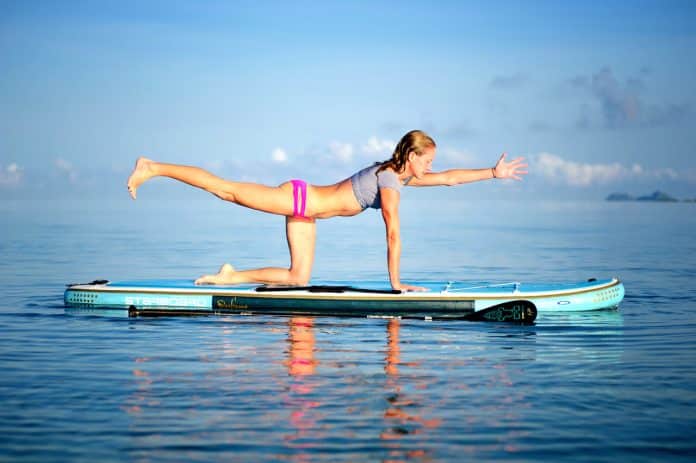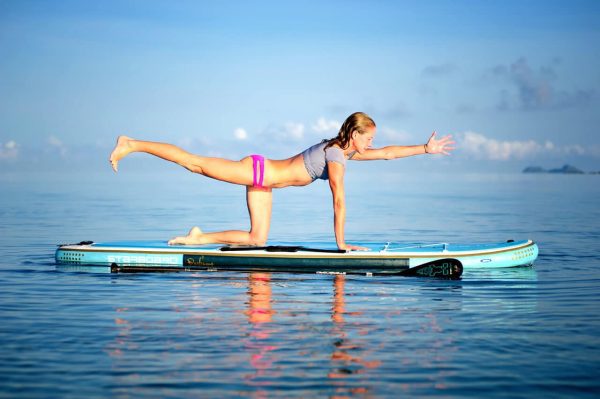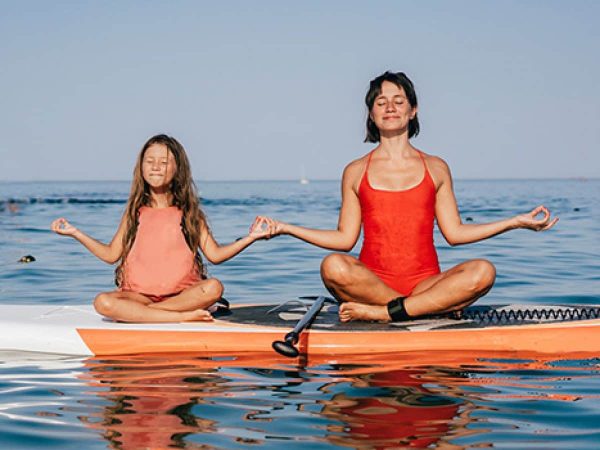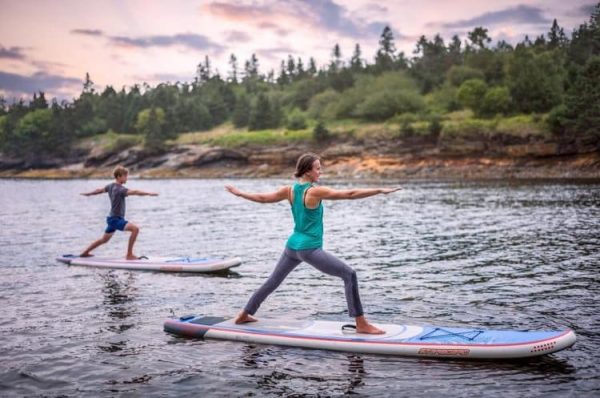If you’re a yoga enthusiast looking for a unique and challenging experience, you may have wondered, “Can I use a SUP board for yoga?” Stand-up paddleboarding, or SUP, has gained popularity recently as a fun and active way to explore the water.
But can it also serve as a platform for your yoga practice?
This article will explore the benefits and considerations of using a SUP board for yoga, helping you decide if it’s the right fit for you. So grab your paddle and join us as we navigate the exciting world of SUP yoga!
This image is the property of www.pumpedupsup.com.
Benefits of Yoga on a SUP Board
There is something extraordinary about practicing yoga on a Stand-Up Paddle (SUP) board. Combining yoga and paddleboarding adds a whole new dimension to the practice, offering a range of benefits beyond what you would experience in a traditional studio setting.
Improved balance and core strength
One of the most obvious benefits of practicing yoga on a SUP board is the improvement in balance. When you step onto the board, you instantly activate your core muscles to maintain stability. As you move through different yoga poses, the subtle movements of the water challenge your stability even further, forcing you to engage your core and increase your balance. Over time, this can significantly improve your balance and core strength.
Increased focus and mindfulness
Practicing yoga on a SUP board requires more focus and mindfulness than practicing on land. With the gentle rocking motion of the water, you are constantly adjusting and readjusting your body to maintain stability. This forces you to be fully present and aware of every movement, breath, and sensation. By cultivating this focus and mindfulness on the board, you can carry it over into your everyday life, improving your ability to stay focused and present in any situation.
Enhanced relaxation and stress relief
Being out on the water has inherent calming and soothing effects that can enhance relaxation and stress relief during a SUP yoga session. Connecting with the natural surroundings can release the tension and stress that might weigh you down. The gentle movement of the water and the sounds of nature create a serene environment that encourages a sense of tranquility and inner peace. Combining yoga and nature provides a powerful therapy for the mind, body, and soul.
Opportunity to connect with nature
Yoga on a SUP board offers a unique opportunity to connect with nature profoundly. Being out on the water allows you to immerse yourself in the beauty and serenity of the natural world. As you practice yoga poses and move through meditation, you can feel the sun’s warmth on your skin, listen to the gentle lapping of the water against the board, and breathe in the fresh, crisp air. This connection to nature can bring a sense of grounding, awe, and appreciation for the world around you.
Fun and unique workout experience
Lastly, practicing yoga on a SUP board is a fun and unique workout experience. It offers a refreshing change of scenery from the usual studio environment and adds an element of adventure and playfulness to your practice. Whether you’re a seasoned yogi or a beginner, the novelty of balancing on a board while flowing through yoga poses can bring a sense of joy and excitement to your practice. It’s a fantastic way to break free from routine and infuse your yoga practice with exploration and adventure.
Choosing the Right SUP Board for Yoga
When choosing the right SUP board for yoga, several factors must be considered. The board you choose will significantly impact your overall yoga experience on the water. Here are some key considerations:
Size and stability
The size and stability of the SUP board are crucial when it comes to practicing yoga. Look for a broader and longer board with a larger surface area, which will provide more stability and allow you to move freely during your yoga practice. Avoid boards that are too narrow or unstable, as they can make it challenging to hold yoga poses and maintain balance.
Deck pad and grip
A good deck pad is essential for practicing yoga on a SUP board. Look for a board with a comfortable, non-slip deck pad that provides cushioning and grip. This will ensure that you have a secure footing and can confidently move through your yoga practice. A deck pad with texture or patterns can also help to enhance your grip.
Weight capacity
Consider the weight capacity of the SUP board to ensure it can support your weight comfortably. If you’re heavier, choose a board with a higher weight capacity to ensure stability and performance. Selecting a board that can accommodate your weight without compromising safety or performance is essential.
Inflatable vs. solid board
There are two main types of SUP boards: inflatables and solid boards. Inflatable boards are generally more convenient for yoga as they can be easily inflated and deflated for transportation and storage. They are also more forgiving if you fall off the board during your yoga practice. However, if you prioritize performance and stability, a solid board may be a better option.
Transportation and storage
Consider the transportation and storage of the SUP board before making a purchase. Inflatable boards are easy to transport as they can be deflated and packed into a backpack. On the other hand, solid boards may require a roof rack or a larger vehicle for transportation. Also, consider where to store the board when not in use and ensure enough space to accommodate its size.
Preparing for a SUP Yoga Session
Before diving into a SUP yoga session, there are several steps you should take to ensure a safe and enjoyable experience. Here’s a checklist to help you prepare:
Finding a suitable location
Choose a location that is suitable for SUP yoga. Look for calm, flat water with minimal boat traffic or strong currents. Avoid areas with rocks or other hazards that may pose a risk during practice. Research local lakes, rivers, or coastal areas that permit SUP yoga and offer a peaceful and serene environment.
Checking weather conditions
Always check the weather conditions before heading out for a SUP yoga session. Avoid practicing on windy or stormy days, as these conditions can make it challenging to maintain stability on the board and can pose safety risks. Ensure that no weather warnings or advisories could potentially jeopardize your practice.
Dressing appropriately
Choose clothing that is comfortable, breathable, and suitable for water activities. Opt for lightweight, quick-drying materials that keep you cool and prevent chafing. Consider the temperature of the water and the weather conditions when choosing your attire. Don’t forget to apply sunscreen to protect your skin from the sun’s rays, especially when practicing outdoors.
Gathering necessary equipment
Make sure you have all the necessary equipment for your SUP yoga session. This includes your SUP board, paddle, leash, personal floatation device (PFD), and other accessories. Double-check that everything is in good condition and fitted adequately before hitting the water. Having a safety whistle and a waterproof bag to keep your belongings safe and dry is always a good idea.
Warming up and stretching
Before stepping onto your SUP board, take the time to warm up your body and stretch your muscles. Start with some light cardio exercises, such as jogging or jumping jacks, to get your blood flowing. Then, incorporate dynamic stretches that target the muscles you will be using during your yoga practice. This will help to prevent injuries and prepare your body for the physical demands of SUP yoga.
Basic SUP Yoga Poses
SUP yoga poses are similar to traditional yoga poses, but they require an extra level of stability and focus due to the moving platform of the SUP board. Here are some basic SUP yoga poses to get you started:
Mountain pose (Tadasana)
Stand tall with your feet hip-width apart, parallel, and your arms relaxed at your sides. Engage your core muscles and distribute your weight evenly between both feet. Find a focal point on the horizon to help with balance. Take deep breaths and feel the connection between your feet and the board.
Warrior pose (Virabhadrasana)
Begin in a wide stance with one foot positioned towards the front of the board and the other foot turned sideways with the heel aligned with the center of the board. Bend the front knee while keeping the back leg straight and strong. Extend your arms out to the sides, parallel to the board. Gaze over your front hand and focus on maintaining balance and stability.
Tree pose (Vrksasana)
Start by standing at the center of the board with your feet hip-width apart. Shift your weight onto one leg and bring the sole of the other foot to the inner thigh or calf of the standing leg, avoiding contact with the knee. Keep your hips squared and engage your core for stability. Place your hands in a prayer position at your chest, or extend your arms overhead.
Downward-facing dog (Adho Mukha Svanasana)
Begin on all fours with your hands aligned under your shoulders and your knees under your hips. Walk your hands forward and spread your fingers, pressing firmly into the board. Lift your hips up and back, straightening your legs and forming an inverted V shape with your body. Relax your neck and gaze between your feet. Focus on grounding through your hands and engaging your core to maintain stability.
Child’s pose (Balasana)
Start kneeling on the board with your big toes touching and your knees hip-width apart. Sit back on your heels and lower your torso down between your thighs. Rest your forehead on the board and stretch your arms out before you. Allow your body to relax and melt into the board, focusing on deepening your breath and releasing any tension.
This image is the property of surfnpaddle.com.
Tips for Practicing SUP Yoga
Practicing SUP yoga requires a slightly different approach than practicing on land. Here are some helpful tips to enhance your experience:
Start with calm and flat water
Choosing calm and flat water conditions is best when starting with SUP yoga. This will provide a stable and less challenging environment for practicing yoga poses on the board. As you gain more experience and confidence, you can gradually explore more dynamic water conditions and add more challenge to your practice.
Paddle out to a quiet area.
Before beginning your yoga practice, paddle to a quiet area away from other swimmers, boats, or distractions. This will allow you to fully immerse yourself in the peacefulness of the surroundings and minimize any potential disturbances during your session. A serene and uninterrupted environment can enhance your focus and enable a deeper connection with your practice.
Engage your core for stability.
Maintaining a strong core is essential for stability and balance on the board. Engage your abdominal muscles throughout your SUP yoga practice to provide a solid foundation and support for your body. This will not only help you stay upright on the board, but it will also improve your body control during yoga poses and transitions.
Use the paddle for support.
The paddle can be a helpful tool for support and balance during SUP yoga. For certain poses that require additional stability, such as the Warrior pose or Tree pose, you can place the paddle on the board and hold it with one or both hands. This will provide an extra point of contact with the board and help you find more balance and ease in the pose.
Look for alignment cues in your surroundings.
Observing your alignment and posture can be challenging when practicing on a SUP board. To overcome this, pay attention to the alignment cues your surroundings offer. Look at the horizon or a fixed point in the distance to align your body and maintain balance. Use the lines or patterns on the board’s deck pad as a reference to ensure that your feet and hands are correctly positioned. Let your surroundings be your guide to finding stability and proper alignment.
Safety Considerations for SUP Yoga
While SUP yoga can be fun and exhilarating, it’s essential to prioritize safety at all times. Here are some safety considerations to keep in mind:
Wearing a personal floatation device (PFD)
When practicing SUP yoga, wearing a personal floatation device (PFD) that is appropriate for water activities is crucial. Even if you consider yourself a strong swimmer, unexpected circumstances can arise that may require the assistance of a PFD. Choose a PFD that fits properly, is comfortable to wear, and is approved by relevant safety standards.
Practicing near shore or in shallow water
For added safety, practice SUP yoga near the shore or in shallow water whenever possible. This ensures that you are never too far from land in case of an emergency or if you need to return to the shore quickly. Shallow water provides a more secure and stable environment for practicing yoga poses on the board.
Being aware of potential hazards
Always be aware of potential hazards in the water, such as rocks, sharp objects, or strong currents. Before getting on the board, survey the area and make sure there are no hidden dangers that could pose a risk to your safety. Familiarize yourself with the local conditions and note any specific safety guidelines or recommendations provided by local authorities.
Avoiding crowded areas
When practicing SUP yoga, avoiding crowded areas frequented by boats, swimmers, or other watercraft is best. These areas can be chaotic and increase the risk of accidents or collisions. Opt for quieter and more secluded spots with ample space to move and practice without interruptions.
Listening to your body and avoiding pushing too far
Always listen to your body and respect its limits during SUP yoga. It’s important to honor discomfort or pain and avoid pushing yourself too far. If a pose feels unstable or causes strain on your body, modify it or skip it altogether. Remember that SUP yoga aims to find balance and harmony, both physically and mentally. Be kind to yourself and practice mindfulness and self-compassion.
This image is the property of cdn.shopify.com.
Modifications for Different Skill Levels
SUP yoga is a practice that everyone can enjoy, regardless of their skill level or experience with yoga. Here are some modifications and variations to consider based on different skill levels:
Beginner modifications
If you’re new to SUP yoga or yoga in general, starting with the basics and building a strong foundation is essential. Begin with simple poses, such as the Mountain pose and Child’s pose, and focus on improving your balance and stability. Use the paddle for support if needed, and modify poses to accommodate your body and skill level.
Intermediate progressions
As you gain more confidence and experience, you can explore more challenging poses and progressions. Begin incorporating poses like the Warrior or Tree pose, which require excellent balance and body control. Experiment with different transitions between poses and explore variations that deepen the stretch and challenge your stability.
Advanced variations
For advanced practitioners, the possibilities for SUP yoga are virtually limitless. Challenge yourself with advanced poses like Handstand or Crow pose, taking into account the added instability of the board. Explore creative transitions and flow sequences that incorporate a variety of poses. Push your limits while always prioritizing safety and mindful practice.
Including options for common limitations
Recognizing and accommodating any limitations or injuries you may have when practicing SUP yoga is essential. If you have limitations in mobility or flexibility, modify poses by using props or adapting the poses to suit your body. For example, you can use a block or a folded towel to support your hands or knees during certain poses. Always listen to your body and make the necessary modifications to ensure a safe and comfortable practice.
Working with props for added support
Props can be valuable tools for enhancing your SUP yoga practice, regardless of your skill level. Consider using a paddle for support during balancing poses or a strap to help with flexibility in seated or standing poses. Blocks, blankets, and bolsters can also provide support and stability, allowing you to explore more profound variations of poses.
Combining Yoga and SUP Fitness
In addition to practicing yoga on a SUP board, you can incorporate SUP fitness elements into your routine. This combination can provide a well-rounded and comprehensive workout experience. Here are some ways to combine yoga and SUP fitness:
Incorporating paddle intervals
Introduce paddle intervals into your SUP yoga practice to add an element of cardio and upper-body strength training. Paddle at a moderate or vigorous pace for a set distance or time, then return to your yoga practice. This enhances cardiovascular fitness and increases overall body endurance and coordination.
Adding strength and cardio exercises
Incorporate strength and cardio exercises on the SUP board to complement your yoga practice. Examples include squats, lunges, push-ups, and planks. These exercises target different muscle groups and elevate your heart rate, providing additional conditioning. By incorporating yoga and fitness exercises, you create a well-rounded workout targeting different aspects of physical fitness.
Creating a full-body workout
SUP yoga provides a unique opportunity to engage and strengthen your entire body. Combining different yoga poses, paddle intervals, and fitness exercises, you can create a full-body workout targeting muscular strength, flexibility, cardiovascular endurance, and balance. This comprehensive approach ensures that you’re reaping the benefits of a well-rounded workout while enjoying the serenity of the water.
Exploring SUP yoga fusion classes
If you’re looking for a more structured approach to combining yoga and SUP fitness, consider joining SUP yoga fusion classes. These classes typically integrate yoga poses, paddle intervals, and fitness exercises into a cohesive and dynamic workout. They are led by experienced instructors who provide guidance and modifications to suit different skill levels.
Utilizing SUP board for additional workouts (pilates, barre, etc.)
The versatility of a SUP board extends beyond SUP yoga. You can also utilize the board for other workouts, such as pilates or barre. These workouts can be adapted to the moving platform of the SUP board, challenging your stability and incorporating the added dimension of water movement. The SUP board becomes a multifunctional fitness tool that enhances your workout experience.
This image is the property of islandmarinerentals.com.
Testimonials from SUP Yoga Enthusiasts
SUP yoga enthusiasts have experienced many benefits from practicing on a SUP board. Here are some testimonials that highlight the positive impact of SUP yoga:
Enhanced physical and mental well-being
“Practicing yoga on a SUP board has transformed my physical and mental well-being. The gentle motion of the water and the connection with nature create a sense of calm and tranquility that I’ve never experienced in a traditional yoga studio. It has improved my balance and core strength and helped me find inner peace and serenity.”
Increased body awareness and balance
“I’ve always struggled with balance, but practicing yoga on a SUP board has dramatically improved my stability and body awareness. Every pose requires focus and engagement of my core, which has translated into better balance on and off the board. I feel more grounded and in tune with my body, thanks to SUP yoga’s unique challenges and rewards.”
Improved muscle tone and flexibility
“Since I started practicing SUP yoga, I’ve noticed a significant improvement in my muscle tone and flexibility. The combination of yoga poses and the added challenge of the water movement has pushed my muscles in new ways. I feel stronger and more toned, and my flexibility has increased, enabling me to explore deeper variations of poses.”
Escape from the daily routine.
“SUP yoga is my ultimate escape from the daily routine. Being out on the water, surrounded by the beauty of nature, instantly transports me to a place of peace and tranquility. It’s a break from screens, deadlines, and responsibilities. It allows me to reconnect with myself and find a sense of calm amidst the chaos of everyday life.”
Building a sense of community
“Practicing SUP yoga has brought together a community of like-minded individuals who share a passion for yoga, nature, and adventure. The sense of camaraderie and connection built among fellow SUP yogis is unparalleled. We support, inspire, and uplift one another, creating a strong sense of community on and off the water.”
Conclusion
SUP yoga offers a unique and rewarding experience combining physical fitness, mindfulness, and connection with nature.
The benefits of practicing yoga on a SUP board extend beyond traditional studio settings, offering improved balance and core strength, increased focus and mindfulness, enhanced relaxation and stress relief, an opportunity to connect with nature, and a fun and unique workout experience.
When choosing the right SUP board for yoga, factors such as size and stability, deck pad and grip, weight capacity, inflatable vs. solid board, and transportation and storage must be considered. Preparing for a SUP yoga session involves finding a suitable location, checking weather conditions, dressing appropriately, gathering necessary equipment, and warming up and stretching.
Basic SUP yoga poses include the Mountain pose, Warrior pose, Tree pose, Downward facing dog, and Child’s pose. Tips for practicing SUP yoga include starting with calm and flat water, paddling out to a quiet area, engaging your core for stability, using the paddle for support, and looking for alignment cues in your surroundings.
Safety considerations include wearing a personal floatation device, practicing near shore or in shallow water, being aware of potential hazards, avoiding crowded areas, and listening to your body. Modifications for different skill levels, such as beginners, intermediates, and advanced practitioners, as well as options for common limitations and props for added support, allow SUP yoga to be accessible to everyone.
Combining yoga and SUP fitness can be achieved by incorporating paddle intervals, adding strength and cardio exercises, creating a full-body workout, exploring SUP yoga fusion classes, and utilizing the SUP board for additional workouts.
Testimonials from SUP yoga enthusiasts highlight the enhanced physical and mental well-being, increased body awareness and balance, improved muscle tone and flexibility, escape from the daily routine, and building a sense of community that SUP yoga brings. In conclusion, SUP yoga offers a unique, enjoyable, and holistic practice that has numerous health benefits and provides a refreshing way to connect with yourself and nature.
With its focus on balance, mindfulness, and physical fitness, SUP yoga is an experience worth trying for both beginners and experienced yogis alike. So grab a board, find a serene spot on the water, and embark on a SUP yoga journey that will rejuvenate your mind, body, and soul.
This image is the property of supready.com.










































